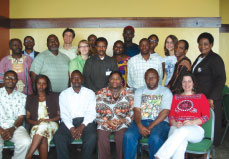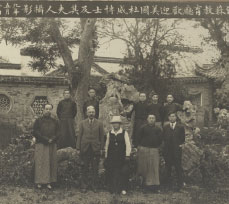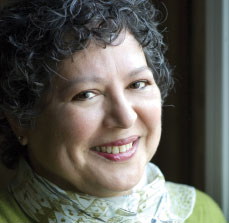Learning From The Rest Of The World
It's a truly global classroom out there. Time for the United States to pull up a chair. It's called "learner-centered pedagogy," and since the 1970s it has been popular with some funders of education reform. Empower a group of students to work together on a project or report, the thinking goes, and they'll raise questions and own the work in ways that plain old didactic instruction could never produce.
By Siddhartha Mitter
Learner-centered pedagogy has been taken up by some international development agencies -- not least as a survival strategy for teachers with sole responsibility for managing classrooms of a hundred students or more.
But it may be that the practice doesn't always transfer wholesale to other cultures.
"When you see it in action in some places, you can see things about it that are built specifically on American values and assumptions about resources," says Lesley Bartlett, TC Associate Professor of Education. "Students who aren't used to challenging a teacher's ideas won't feel comfortable with this pedagogy. Another issue is that when five or 10 kids have to share a single textbook, they can't do much independent work at home. And language policy can be a barrier, too. In Tanzania, for example, students shift from Swahili to English in secondary school, and they often have great difficulty expressing themselves in a language they're struggling to learn."
Between 2008 and 2011, Bartlett and Fran Vavrus, a former TC faculty member now at the University of Minnesota, collaborated with faculty from Tanzania's Mwenge University College of Education to improve reading and writing in secondary schools. Based on what she saw, Bartlett believes learner-centered pedagogy may need some rethinking in the United States as well.
"American schools in poorer neighborhoods often lack for textbooks and other resources," she says. And even in more affluent schools, "it's not enough to say, OK, we're all going to read a book and write a report together. Without the right management, that approach can produce very shallow learning.
"To me, that's the real value of a comparative international perspective," Bartlett adds. "We're quick to say that something discovered in one place, at one time, describes how all humans learn or act. But when we expose those theories to a broader range of human experience, we can nuance them and say, -'yes, but only under these circumstances.'"
Bartlett's conclusions come at a watershed moment in education when the readily available "range of human experience" is becoming exponentially broader. Nations such as China, India and Brazil have come to the fore as economic powers, while Singapore, Finland and South Korea are setting the pace academically. Ideas about education policy and practice, as well as actual aid, are increasingly flowing among developing nations rather than to them from wealthier countries. And in the United States, immigration has dramatically altered the composition of primary and secondary school classrooms. International students are enrolling at U.S. colleges and universities in record numbers. Meanwhile, technology increasingly bridges many divides.
"We are now endlessly encountering difference," says David Hansen, TC's John L. and Sue Ann Weinberg Professor in the Historicaland Philosophical Foundations of Education. "The idea of hiding from others has become a chimera."
But in this new era of give and take, is the United States -- so long accustomed to the giving role -- truly ready to take?
"In this country, we don't really teach about how we can learn from other nations," says Gita Steiner-Khamsi, Chair of TC's Department of International and Transcultural Studies, who is Iranian by birth, Swiss by upbringing and a U.S. citizen by naturalization. "The U.S. is just not that interested in what's going on around the world."
From its earliest days, Teachers College has stood as an exception to that rule. John Dewey and James Earl Russell were heavily influenced by European thinkers like Friedrich Frobel and Johann Pestalozzi. The ideas of Dewey, the iconic TC philosopher, shaped the modern classroom as a place of hands-on exploration; Russell, TC's first dean, taught the world's first course in comparative and international education.
Beginning in 1923, the College's International Institute sent faculty to study education systems in countries around the world. The Institute initiated the creation of the International Education Library -- collections of textbooks and other materials from other nations, which are kept today in TC's Gottesman Libraries. The Institute also granted scholarships for study abroad and served as a powerful draw for international students coming to TC, who numbered more than 1,200 by the beginning of the Depression. At one point, the College's international student population included roughly one-fifth of all Chinese education students in the United States.
Yet even at TC, knowledge tended to flow outward.
"A lot of projects were like a wholesale transfer to other countries of what worked here," says Steiner-Khamsi. "Wherever there were Americans, it was about exporting student-centered learning, associations, decentralization -- all the things associated with American democracy." One TC engagement was a 25-year effort in Afghanistan that beginning in 1954 produced curricula, textbooks and the country's first generation of education professors. Another was Teachers for East Africa, which provided Kenya, Tanzania and Uganda with educators as those countries transitioned from colonial rule to independence during the early 1960s.
Today, TC continues to serve countries around the world, but its operating philosophy has changed.
"We approach international collaboration as precisely that -- a process in which the goal is to work with clients to develop solutions to their needs rather than imposing our ideas and values," says Thomas Corcoran, Vice President of International Affairs. Much of that work has focused on providing professional development for teachers and principals -- efforts that have benefited from TC's relationship with Columbia's Global Centers nine countries.
"Working with Columbia is ideal for us, because our goal isn't to create TC campuses or outposts around the world," Corcoran says. "Instead, we want to bring our expertise to bear where it can be helpful, and also create opportunities for our faculty and students to conduct research and glean insights that will enrich the College and American schooling in general."
It was through Columbia, for example, that the Consortium for Policy Research in Education (CPRE) at TC helped set up the Queen Rania Teacher Academy in Jordan, where it has since worked with Jordan's Ministry of Education to reshape teacher preparation and provide specific instruction to hundreds of teachers in mathematics, science and the teaching of English. Far from an act of linguistic imperialism, the latter effort addresses Jordan's stated need to equip a new generation of young people with the world's lingua franca for commerce and other fields. CPRE-TC is helping with similar professional development efforts in Mexico, the Palestinian territories, Poland and Thailand.
In fact, aid efforts by TC increasingly guide recipients in crafting solutions. In Pakistan, Steiner-Khamsi is leading a USAID-funded effort to create two-year associate and four-year bachelor's teaching degrees. Nearly 6,000 Pakistani students, policymakers and faculty members from 75 colleges and 22 universities will participate in the project's activities.
"We need a strong civil society here in Pakistan that is safe and secure. We cannot produce that without good education," Mahmood Ul Hasan Butt, Pakistan's Chief of Party for the Preservice Teacher Education Program of the USAID Teacher Education Project, told The Christian Science Monitor in June 2012. "From John Dewey onwards, Teachers College has been the leader of the progressive education movement. As an institution, it has historically asked questions such as, -'How do we think?' and -'What is the scientific method of solving problems?' So we came to the mecca of educational reforms."
To Sharon Lynn Kagan, TC's Marx Professor of Early Childhood and Family Policy, honoring that kind of trust entails respecting not only the wishes but also the values of international colleagues while still delivering guidance that is grounded in research. That was the challenge Kagan faced while working with UNICEF to help more than 40 of the world's poorest nations develop early childhood learning standards. The aim was to enable each nation to adapt research on early childhood education to its own cultural, geographic and sociological contexts.
"We have to be very careful as one of the largest and arguably the most powerful country in the world not to impose our values and our context in these nations that have very different approaches and very different political lives," Kagan says. "Here we separate church and state, but when I'm working in a country like Jordan, religion must be part of the curriculum -- it absolutely must be, there's no question about that. So, you've got to step back from your conventional beliefs."
Yet Americans don't tend to do that, perhaps in part because at the most basic level -- our primary and secondary schools -- "we don't instill a sense of appreciation for other cultures," David Hansen says.
For example, many U.S. schools teach units devoted to world civilizations or the culture and history of foreign countries -- but the effect is still analogous to the famous Saul Steinberg cartoon lampooning a New Yorker's view of the world, with two avenues in Manhattan filling most of the map, and Russia, China and Japan appearing as tiny slivers just west of New Jersey.
"Children in New York City should obviously have in-depth experience of the history of the city and its terrain," Hansen says. "But the ideal cosmopolitan curriculum would also mean, for example, not just a China unit in a world history course, but an immersive experience in China that extends over the entire course of middle or secondary school."
American reactions to the International Baccalaureate (I.B.) program reflect this country's deeper ambivalence toward internationalism. More than 1,400 U.S. schools, most of them public, now offer curricula developed by the I.B., an international foundation based in Geneva whose mission is "to create a better and more peaceful world through intercultural understanding and respect." These curricula, originally created for expatriate children in different countries, equip students to attend top-ranked universities like Harvard, Oxford and Cambridge. Yet in the United States, there has been a backlash against the I.B. among some who mistakenly assume the courses import "foreign content" that threatens American values.
Similar issues play out around the teaching of foreign languages. There is growing interest in economically "hot" languages such as Chinese, which is offered in some 1,600 schools across the country. Chinese has become the nation's third most-tested language, after Spanish and French, at the advanced placement level. The field of second-language acquisition has seen the rise of methods such as task-based language teaching -- for example, learning to read a Chinese train schedule for an actual or hypothetical trip, which "accommodates learning as it happens naturally," says ZhaoHong Han, Professor of Language and Education.
But Han says this approach has yet to be generalized into the teaching of Spanish and other, less traditional foreign languages in the United States. Meanwhile, in the view of experts at TC, language policy for children who grow up in non-English-speaking households took a wrong turn in the 1980s, moving away from bilingual approaches to an English-only emphasis.
"Children need access to all the resources they have in order to learn, and their home languages are a major resource, because you build on what you know in order to learn what you do not know," say Maria Torres-Guzman, Professor of Bilingual Education. "I also see bilingual education as a very important thing for language-dominant and mainstream populations, because it gives them the resources to learn about new worlds and to become more flexible. Unfortunately, a lot of the anti-bilingual education sentiment is tied very closely to anti-immigrant feelings, particularly in an uncertain economy."
No one is complaining about the economic returns on the international student population at American colleges and universities, which surged from about 548,000 in 2000 to nearly 765,000 in 2011. But there are concerns about how the visitors are interacting with American students and professors.
"We are not ready for them, and they are not ready for us," says Xiaodong Lin, Associate Professor of Technology and Education, who studies issues in trans-cultural collaboration.
Recent studies bear her out. Many international students complain that they are unable to form close ties with their American classmates and instead socialize and collaborate mostly with one another. The larger the international student population, the greater the risk of such "enclaving," says Lin.
"The problem can only be resolved by both parties working together to understand each other's values and practices," she says. Lin is currently researching strategies that call for hosts and visitors alike to make their values explicit in order to enhance understanding.
Samantha Lu, Director of TC's Office of International Services, believes that American students need cross-cultural orientation as much their visiting international peers.
"U.S. students need to be encouraged to learn about the world and to participate in a study abroad program in college," Lu says. "Certainly faculty at institutions such as TC should include a component of internationalization in their courses, but the process really needs to begin during the K-'"12 years."
For now, the market may be the strongest force driving the internationalization of education -- and forcing American educators, in particular, to contend with other cultures. That is, if you want your kids to find a job in what may well turn out to be the Chinese century, then make sure they study Chinese.
Hansen sees the benefits of such pressures, but urges keeping larger education goals in mind.
"The aim is not just to become better capitalists," he says. "Teaching languages, opening the curriculum, isn't just a means to an economic end. It's a formative process that has everything to do with what kind of culture we're going to be."
Published Thursday, Jun. 27, 2013




